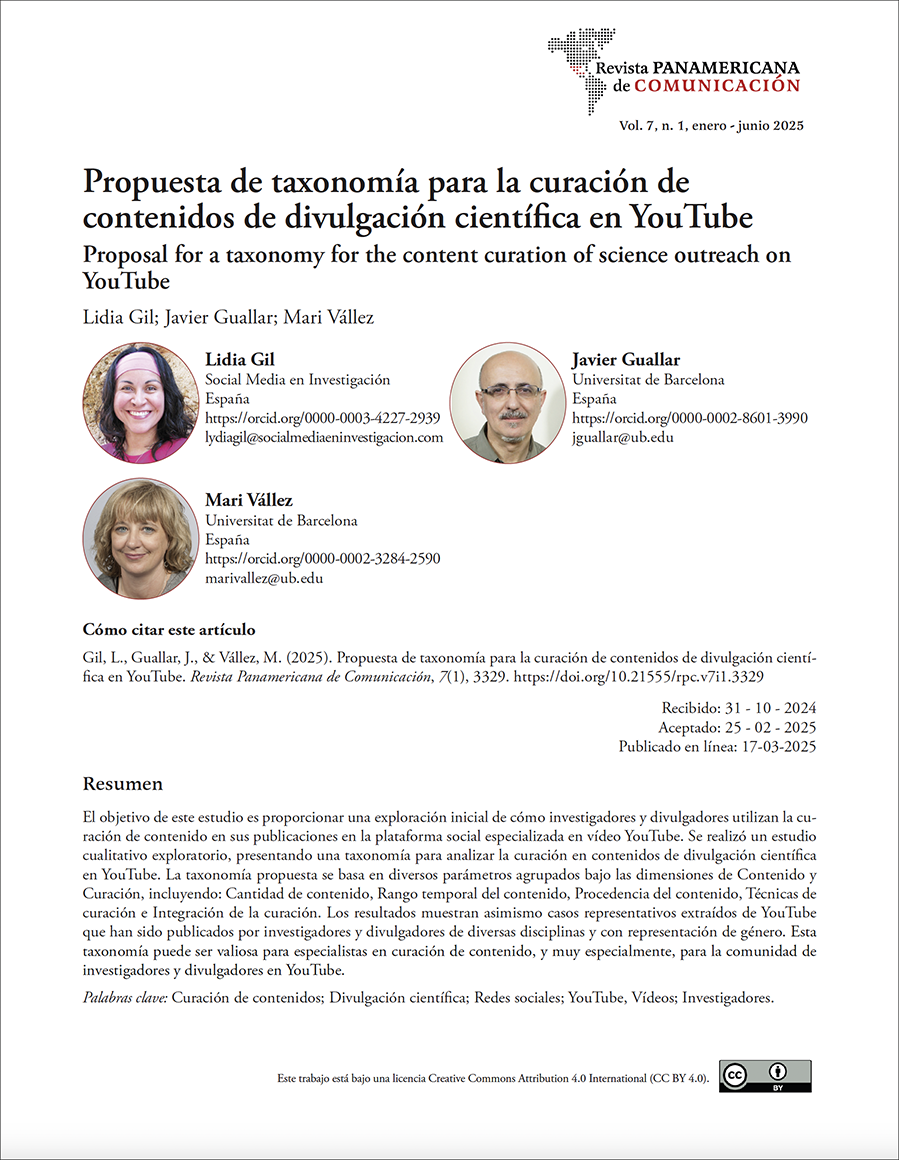Proposal for a taxonomy for the content curation of science outreach on YouTube
Main Article Content
Abstract
The aim of this study is to provide an initial exploration of how researchers and communicators utilize content curation in their publications on the video-focused social platform YouTube. An exploratory qualitative study was conducted, presenting a taxonomy for analyzing scientific dissemination content curation on YouTube. The proposed taxonomy is based on various parameters grouped under the dimensions of Content and Curation, including: Quantity of content, Temporal range of content, Source of content, Curation techniques, and Integration of curation. The results also showcase representative cases drawn from YouTube, published by researchers and communicators from various disciplines and with gender representation. This taxonomy can be valuable for content curation specialists, and especially for the community of researchers and communicators on YouTube.
Article Details
Section

This work is licensed under a Creative Commons Attribution 4.0 International License.
How to Cite
References
Allgaier, J. (2019). Science and environmental communication on YouTube: Strategically distorted communications in online videos on climate change and climate engineering. Frontiers in Communication, 4, 2–15. https://doi.org/10.3389/fcomm.2019.00036
Ames, H., Glenton, C., & Lewin, S. (2019). Purposive sampling in a qualitative evidence synthesis: a worked example from a synthesis on parental perceptions of vaccination communication. BMC Medical Research Methodology, 19, 26. https://doi.org/10.1186/s12874-019-0665-4
Bhargava, R. (September 30, 2009). Manifesto for the content curator: The next big social media job of the future? Rohit Bhargava.com. https://tinyurl.com/4mkpvcuj
Buitrago, Á., & Torres-Ortiz, L. (2022). Influencers de ciencia en YouTube. Divulgación científica en el contexto español de la plataforma hegemónica de vídeo online. AdComunica, (24), 177–200. https://doi.org/10.6035/adcomunica.6558
Cascón-Katchadourian, J., Artigas, W., & Guallar, J. (2023). Curación de contenidos en las redes sociales de revistas de Información y documentación de Iberoamérica. BiD, (51). https://doi.org/10.1344/bid2023.51.04
Cisco (2019). Cisco visual networking index: forecast and trends, 2017–2022. CISCO. https://www.futuretimeline.net/data-trends/pdfs/cisco-2017-2022.pdf
Clifton-Ross, J., Dale, A., & Newell, R. (2019). Frameworks and models for disseminating curated research outcomes to the public. SAGE Open, 9(2), 1–13. https://doi.org/10.1177/2158244019840112
Cui, X., & Liu, Y. (2017). How does online news curate linked sources? A content analysis of three online news media. Journalism, 18(7), 852–870. https://doi.org/10.1177/1464884916663621
Deshpande, P. (2013). 6 content curation templates for content annotation. The Curata Blog. https://curata.com/blog/6-content-curation-templates-for-content-annotation
De-Santis-Piras, A., & Jara-Cobos, R. V. (2020). Comunicación estratégica de la ciencia con YouTube: el papel del comunicador/científico. En A. Torres-Toukoumidis, & A. De-Santis-Piras (Eds.), YouTube y la comunicación del siglo XXI (pp. 117–136). https://doi.org/10.16921/ciespal.14.9
Fecyt (2024). Libro blanco de las unidades de cultura científica y de la innovación (UCC+I) Edición 2024. Fundación Española para la Ciencia y la Tecnología. https://www.fecyt.es/publicaciones/libro-blanco-de-las-unidades-de-cultura-cientifica-y-de-la-innovacion-ucci
Gil, L., & Guallar, J. (2023). Científicos en redes sociales. Divulgación y curación de contenidos en Twitter: taxonomía y casos. Index.Comunicación, 13(1), 55–77. https://doi.org/10.33732/ixc/13/01Cienti
Guallar, J., Codina, L., & Abadal, E. (2020). La investigación sobre curación de contenidos: análisis de la producción académica. Ibersid, 14(1), 13–22. https://doi.org/10.54886/ibersid.v14i1.4653
Guallar, J., & Leiva-Aguilera, J. (2013). El content curator. Guía básica para el nuevo profesional de internet. Barcelona: Editorial UOC, Colección El profesional de la información.
Gutiérrez-Lozano, J. F., & Cuartero, A. (2020). El auge de Twitch: Nuevas ofertas audiovisuales y cambios del consumo televisivo entre la audiencia juvenil. Ámbitos: Revista Internacional de Comunicación, 50, 159–175. https://doi.org/10.12795/Ambitos.2020.i50.11
Hernández-Campillo, T. R., Carvajal-Hernández, B. M., & Legañoa-Ferrá, M. A. (2018). La curación de contenidos científicos: una herramienta para la gestión informativa en los docentes universitarios. Revista Publicando, 5(14), 258–272. https://www.revistapublicando.org/revista/index.php/crv/article/view/1244/0
Juárez-Popoca, D., Torres-Gastelú, C. A., & Herrera-Díaz, L. E. (2017). Las posibilidades educativas de la curación de contenidos: una revisión de literatura. Apertura, 9(2), 116–131. http://doi.org/10.32870/Ap.v9n2.1046
Kemp, S. (July 31, 2024). Digital 2024 July global digital statshot report. DataReportal. https://datareportal.com/reports/digital-2024-july-global-statshot
Kidambi, M. (February 26, 2024). Since Twitter became X… Altmetric. https://www.altmetric.com/blog/since-twitter-became-x
León, B., & Bourk, M. (2018). Investigating science-related online video. En B. León, & M. Bourk (Eds.), Communicating science and technology through online video: Researching a new media phenomenon (pp. 1–14). London: Routledge Taylor & Francis Group. https://doi.org/10.4324/9781351054584
López-Borrull, A., & Ollé, C. (2019). La curación de contenidos científicos como respuesta a las noticias y a la ciencia falsas. Anuario ThinkEPI, 13, e13e07. https://doi.org/10.3145/thinkepi.2019.e13e07
Parra-Valero, P. (2016). Curación de contenidos desde bibliotecas: competencias, herramientas y aplicaciones. Ciência da Informação, 45(2). https://doi.org/10.18225/ci.inf.v45i2.3805
Patiño-Barba, M. L., Padilla-González, J., & Massarani, L. (2017). Diagnóstico de la divulgación de la ciencia en América Latina: Una mirada a la práctica de campo. RedPOP. https://static1.squarespace.com/static/5f524043e55fb97cf38acc79/t/5fca3a4d55485c3109bc7cf8/1607088755561/Diagnostico-divulgacion-ciencia_web.pdf
Similarweb (2024). Top websites ranking. Similarweb.com. https://www.similarweb.com/top-websites
Soukup, P. A. (2014). Looking at, through, and with YouTube. Communication Research Trends, 33(3), 3–34. https://scholarcommons.scu.edu/comm/102
Thorson, K., & Wells, C. (2016). Curated flows: A framework for mapping media exposure in the digital age. Communication Theory, 26(3), 309–328. https://doi.org/10.1111/comt.12087
Zaragoza, J. C., & Roca-Marín, D. (2020). El movimiento youtuber en la divulgación científica española. Revista Prisma Social, (31), 212–238. https://revistaprismasocial.es/article/view/3942

